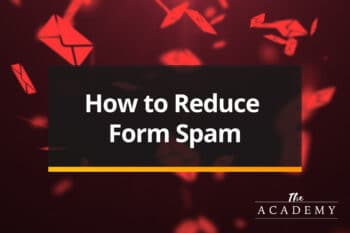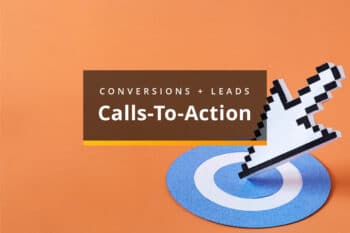
(Updated 1/2022)
Today we’re talking about designing a new website. For many people, this means hiring an actual web designer. Someone that will help them to decide how their website is going to look. They’ll go through the process and create multiple color schemes and layouts. They’ll debate about the right shade of blue, and explore all the different font styles, sizes, and weights that are presented. There will be discussions about whether they need headshots and bios for everyone in the company. And there will certainly be discussions about whether the most important information on the homepage is “above the fold”.
This is how it’s done. Right?
Wrong.
Developing an effective website involves many specific elements that are intimately dictated by the business, their goals, their brand, as well as many external factors such as the industry, their niche, their region, and on and on. How you create a great website also needs to be closely aligned with your overall digital marketing strategy.
We have many potential clients that have come to use in the past and they request a design “spec”. It’s been a while since this has happened, but essentially they ask us to prove our “design chops” and work through a concept of how their site is going to look before they hire us. For me, this is akin to asking a mechanical engineer to properly design an airplane and deliver a safe and effective prototype before they’re hired to do the job.
Another way this happens from time to time is that the client sends us an RFP (Request for proposal) that contains some information about their needs and goals. It’s basically what they think they want and need, and we just need to put a price to it and a timeline.
Responding to an RFP is hard enough. But there is even one more approach, and it’s the most common. Many people try to engage us just by asking “how much is a new website” and “how long will it take”?
Responding to these requests is difficult and it’s always a hurdle to working with a company. People do tend to move on to other companies that are willing to engage in this way and we lose the opportunity to move forward on the project. But we’re “ok” with this. why? It’s because when someone asks you how much and how long, the honest truth is that we’re just stabbing in the dark. If we were a mechanical engineer that’s designing a plane, we would have no idea how big of a plane, how fast you need it to go, how high it needs to fly, and how to ultimately make it safe to carry passengers and cargo to their destinations. Does it even carry cargo? Hopefully, you get my point.At best, we’re not going to be able to do the best work possible and deliver what the client really needs. Worst case, the client will be disappointed, confused and many times, angry because we were not aligned with what they expected and were unable to deliver it on a random timeline. At least nobody is going to die if the website is a failure I guess, right.
I’ve been doing this for a long time now. I coded and uploaded my first page to the internet in 1996, and there is one thing that I’ve been forced to admit. You can’t build an amazing website without a detailed strategy, a comprehensive plan, and specifically defined goals. ALL of this can’t be guesswork. It’s impossible to estimate properly. Doing so is a recipe for disaster, for both sides, 99% of the time.
So what’s the answer?
We’ve found that the only possible answer is to actually engage the potential client with a “Discovery” project. In this project, we’ll do all the necessary work to really understand the needs and goals of the client, and we get paid for our expertise and time. Many times the client isn’t even sure what they need and we’re able to use our experience to guide them down the right path. Getting paid for our time ensures that we don’t cut corners and guess. In short, we do it right.
- We’ll work to understand their company, their goals, challenges, their brand, their niche and industry, and the competition.
- We’ll discuss their brand, their voice, and the look-and-feel of the site.
- We’ll explore all the requirements including how much content we need to create, what special features or requirements are necessary, and uncover all the client’s unarticulated expectations.
- Most importantly, we’ll work to fight against the belief that if you build it, they will come.
They will not.
When building a new website, we need to understand how to get people there, and then, what we need them to do when they get there. Ultimately, we need a specific plan around how to get them to do it. We need to understand what it means to turn a visitor, into a customer.
And at the end of the day, based on what has to be delivered, we’ll provide a firm timeline that we can commit to and that the client is happy with.
All of these things cannot be guessed at or estimated. If we’re unable to uncover and intimately understand all of these requirements, the project is generally destined for mediocrity or even failure. But when we’re allowed to go through the process of discovery to research, plan, strategize and put a plan together, the client can walk away with a nice little bundle of value that they can take to any company to quote. Or they can simply decide to move forward with us on the project and feel good that the project is based on a solid plan that ensures that everyone is on the same page.
Developing a website marketing strategy
So if you’re still with me, let’s take a few minutes and dive specifically into one of the major things that many people tend to skip when they’re developing a new website, and that is the strategy that gets people to the website and turns them into an actual customer. Don’t worry, we’ll talk about design soon.
To simplify it down, here are the 3 main questions you should explore.
- Who do you want to come to the website?
- How are you going to get them to your website?
- What do you want them to do when they get there?
These questions may be broken up into many secondary questions, studies, and a handful of outcomes. Understanding the industry, niche and competition are important. We also want to understand the target audience. For example, it might be the actual business owner that you want to sell to. Maybe it’s a manager or supervisor that makes the decision? Is the business local, national or worldwide? There are many more questions that help you to uncover your target audience. This is called your buyer persona. It’s your ideal customer, and this is just one of the things we need to explore and understand from the beginning.
Once the first question is answered, you have to ask yourself how they’ll find your website? Remember, the last thing you want to do is say “if we build it, they will come.” These days, the internet is vast, the competition is great, and if your master plan is to just build a new website and “put it out there”, you’re bound to be disappointed. You should ask yourself from the beginning, what is your strategy to position yourself in front of as many potential customers as possible? What is your available budget? What does your budget need to be to actually compete? Will you be making an ongoing investment in SEO to rank organically in the search engines? For what keywords? Will you use paid advertising campaigns? Again, do you have a realistic budget for this? Will it be niche advertising on industry sites? How does email marketing figure in? How does social media figure in? Does it figure in at all for your type of business? There are many questions to be answered.
Next, after you successfully drive traffic, what happens when they get to your site? How does your website convert visitors to clients or customers? Do you want them to call? Email? Subscribe in some way? What can you do on the site to convince them to connect with you or engage? Do you have any incentives? How can you remove hurdles and make it super easy? What if it takes a while to gain someone’s trust because what you sell isn’t a small investment? How do you connect with them to start this process and continually engage and educate them? These are the things that will turn a passive web presence into a living, breathing, revenue-producing component of your business. While the design is important at many levels, a successful website starts with strategy and the strategy drives the design.
At the end of the day, I’m hoping that you can see why asking a professional to “guess” at a cost and a timeline is a recipe for failure. There is so much important work to be done upfront to make a new website successful.
So, what do I know about being an “expert” in your industry. Sometimes, nothing… and that’s “ok”.
Are we experts? Yes, in marketing most types of business online.
Many times I get this question “what do you know about my product, services, industry or niche?” We face this question from potential clients when they ask us if we’ve done work within their industry. While direct work within a particular industry can be helpful, we find that an objective approach to a website and strategy serves our clients well.
Honestly, every business is different in subtle ways. It might be the way you want to position your company in the market or a certain set of values that you want to communicate. You might focus on a specific service or have a certain strength that your competition does not. You might even be JUST like your competition in every way, but the way to succeed is doing everything you can to differentiate yourself and stand out as the right choice among many.
This, is where an outsider can be an asset.
Our job is to find relevant, targeted visitors and convert them into paying customers and clients. We can do that successfully in ANY industry with the correct research and a unique strategy. Our job is to help you to be found and stand out. Not to prescribe a cookie-cutter approach that everyone else is using. We are not experts in any particular industry except for marketing, and THAT’S why a unique strategy will make you successful on the web and make your website work for your unique business.
I do just want to take a moment here… it may sound like I’m trying to sell you on working with me and my company. That is not my goal here. What I’m trying to do is sell you on the simple idea that a great website is much more than the look-and-feel, and colors that you choose. It’s about having the right team of people come together to create something great that works FOR you while you sleep.
Trying to seek out a company with experience in your industry is going to be tough, so what you should be doing is trying to find a company that wants to talk about developing a unique strategy WITH YOU and learning how to best connect with the right target audience..
In my experience, a company that “specializes” in developing a website within a certain industry doesn’t mean much more than they’ve found a niche that they can exploit in many cookie-cutter ways. Give them a try and I’ll bet that they start talking about their “products”, “the template”, “the tools you have to update your site”, “what package size you’re purchasing” and “your contract length” before they start talking about a unique strategy that actually creates lasting revenue for your business.
Lastly, familiarity can actually breed a skewed perspective… or more to the point, familiarity breeds jargon. In the world of search marketing, it’s imperative to let the audience drive the language. Too often our clients are very entrenched in their industry—so much so, that the resulting language is far different from that of the actual customer that’s searching for what they do online. This may seem counterintuitive, but this is a common reason why many companies find their websites of little use to anyone outside of their company. That’s where an outside marketing partner can actually help because they’re able to step outside of the industry and look in to see how they can help you reach your ideal customers in real, tangible, measurable ways.
How does strategy affect the look-and-feel, and the success of the website?
So we’ve talked a lot about strategy and planning and goals, and all the rest. But let’s briefly go back to the beginning where things usually begin, and that is, you want to design a new website, right?
Design is critically important to the success of your site. This is often referred to as UX and UI design, that is, user experience and user interface design. Both disciplines work together and are guided by your strategy and goals. Essentially we want to create an enjoyable, seamless, successful experience for visitors that interact with all aspects of your business online.
Everything we do on a site; from the graphics, to the structure and navigation, the words that we use, the position of text and elements on the page, the color selection, the fonts and the subtle voice of the messaging is based on the initial project goals, conversations with our clients and the research that we conduct during the initial phase of web development. All of this will drive your design and help to answer the three questions that we mentioned previously and speak to your target audience — your ideal client.
The research and strategy guides the design of the information architecture. How do people know at a glance what you do, what services you offer and and what exactly do you call them? How do you make it easy for them to find what they need? What links to what, what is top-level, what is sub-navigation, what is the primary site conversion path, what areas are both hierarchically and contextually linked, etc. This research even dictates what shows up on the home page and how we guide people through your site and tell your unique story throughout.
And finally, we’re back to where we started — the look and feel of your website. Essentially, where many people begin, is where you should actually end. Deciding on the look-and-feel, the colors, the fonts, the photos and the overall vibe is the icing on the cake. The look-and-feel is the packaging for your message. Your design can be one of the elements that build trust. Your design insures that visitors don’t leave immediately because your site looks outdated or fly by night. Your design sends subtle messages that you’re the type of business that they want to engage with. And again, most importantly, the subtle aspects of design ensure that you’re able to begin to create trust. Trust is the foundation of every great relationship. At the end of the day, if all the work we’ve done only does one thing, creating trust through a unique and high-quality web design would be an honorable goal because it’s so important to the success of everything else.
Most Popular Articles

Seeing Favicons in Your Google Search Results? Here’s Why…
Have you noticed anything different in your Google Search results lately? Google added tiny favicon icons to its organic search results in January. It was…

Business Growth and Digital Marketing News & Tips 4-14-24
Did you know? It’s five to twenty-five times more expensive to acquire a new customer than to retain an existing one. Increasing customer retention by…

Business Growth and Digital Marketing News & Tips 3-28-24
With the desire for precise measurement tools to determine ROI, there has been a rise in attention metrics. These metrics, which often utilize eye-tracking data,…








